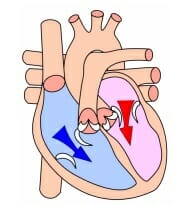Diastole Definition
Diastole is a phase in the cardiac cycle, during which the heart relaxes and allows blood to refill each atrium and each ventricle. Diastole is the longer of the two phases, and the contraction of the muscles in the heart happens rather quickly. The longer diastole phase is necessary to allow blood to return to the heart. Diastole can be divided into two different types, atrial diastole and ventricular diastole, as the atria and ventricles stop contracting at slightly different points.
During ventricular diastole, the decrease of blood pressure inside the ventricle causes a change in the valves inside each ventricle. This can be seen in the image above. The semilunar valves close, shutting the routes out of the heart from the ventricles. The drop in pressure also opens the atrioventricular valves, which allows blood to flow through each atrium into the separate ventricles. During diastole, the majority of the blood that will be pushed through the ventricle enters without force. The end of diastole is brought on by the contraction of the atria, which causes an atrial kick of more blood into the ventricles. This blood is then squeezed out of the heart during systole, the next phase of the cardiac cycle.
Related Biology Terms
- Systole – The opposite phase of cardiac cycles, in which the heart contracts.
- Atrial Kick – The small amount of blood added by the contracting of the atria at the end of diastole phase.
- Atrioventricular valves – The valves between the atria and ventricles of the heart.
- Semilunar Valves – The valves of the heart that exist between the ventricles and the arteries exiting the heart.
Quiz
1. Blood from the right atrium spills through the tricuspid valve into the right ventricle. The same happens from the left atrium to the left ventricle. The muscles are relaxed. What is this phase of the cardiac cycle called?
A. Systole
B. Diastole
C. This never happens
2. An electrician is working on an electrical outlet. His heart is beating normally, cycling from systole to diastole phases. The electrician grabs a live wire and electricity surges through his body. What phase is his heart in?
A. Systole
B. Diastole
C. This muscle contraction is neither

